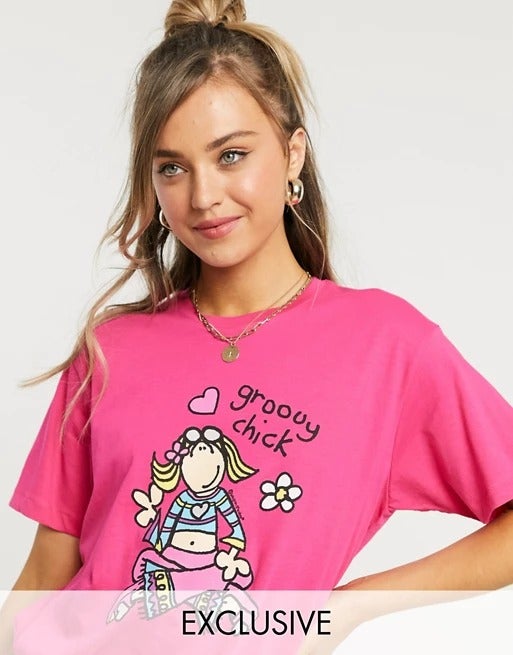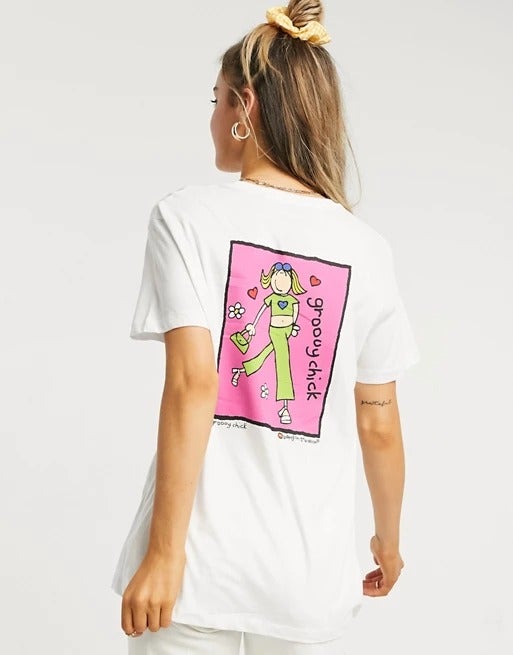I Can’t Resist Buying Clothes That Remind Me Of My Childhood
I was returning an online order to Urban Outfitters when I saw it. A cream cardigan featuring floral embroidery and a scalloped trim. It wasn’t my style. Not even close. But it was reminiscent of the cardigans my mum’s friend knitted for me as a toddler and just like that, it found its way into my wardrobe.
It’s not the only time this has happened. I just can’t resist buying clothes that remind me of my childhood. A cotton T-shirt featuring my favourite Powerpuff Girl. A cable knit cardigan adorned with a faux fur collar similar to one owned by my childhood Build-A-Bear rabbit. I have a serious case of fashion nostalgia and it seems I’m not the only one.
AdvertisementADVERTISEMENT
The thing about nostalgia is that it isn't necessarily the past we actually experienced but rather a romanticised imagining of it, as behavioural psychologist and author of The Psychology of Fashion, Professor Carolyn Mair PhD says: “It is considered to be a positive, yet bittersweet emotion, mood or feeling felt when we yearn for a [potentially] imaginary world which is better than the world we inhabit in reality.” Studies show that reflecting on fond memories of the past can be reassuring during uncertain times and that we turn to nostalgia for comfort in times of upheaval. It seems fitting then, during the most uncertain year on record, that nostalgia has taken over our wardrobes. Baby tees printed with Lisa Frank-esque baby animals, school disco-ready butterfly clips and platform jelly shoes are all once again in high demand among Gen Z and millennials who are turning to the characters and styles of their childhood for inspiration.
Sure, the ‘90s and ‘00s revival has been growing for some time now, but rather than countercultural or catwalk trends like grunge and minimalism, we’re instead reaching for the aesthetic signifiers of our youth. “When we recollect our childhoods, we might remember being cared for, protected and nurtured, having fun in a time of discovery when we weren’t weighed down by the responsibilities of adulthood,” Mair explains. “We might then feel nostalgic for this period and this makes us feel positive.” What easier way to escape from the anxieties of the pandemic than reliving snapshots of the past that we look upon more fondly?
AdvertisementADVERTISEMENT
Ella Sambrook, 19, is the owner of @elladesignstatements, a Depop shop selling designs handmade from recycled children’s fabrics featuring the likes of Groovy Chick, Hello Kitty and Bratz. “I think the reason they are so popular is definitely a sense of nostalgia. There’s a certain level of comfort and also an element of humour in reclaiming these characters and prints.” She continues: “Groovy Chick was always a favourite when I was little and whenever I wear the prints, I have people coming up to me saying, ‘Woah I remember Groovy Chick. I had those bedsheets!’”
This sort of nostalgia is somewhat new. Our parents didn’t spend their 20s yearning for the clothing of their youth, so what are the driving forces behind Gen Z and millennials’ obsession with childhood? The Psychology of Fashion explains that due to rapid advances in technology in the 1990s and the development of social media, “opportunities for exposure to fashion imagery have increased significantly” and “social networking sites are becoming the most influential medium for the promotion and distribution of fashion ideas and ideals.” WGSN has been tracking the revival of Y2K fashion and culture on social media over the past few years, finding a number of social media accounts dedicated to nostalgia for the fashion, films and music of the 1990s and 2000s. And as the first generations to grow up online, Gen Z and millennials are said to spend more time on social media than any other generation. We are therefore being exposed to the vast amount of nostalgic content out there at a much more rapid rate than our predecessors.
AdvertisementADVERTISEMENT
Cassandra Napoli, an insight strategist at WGSN, also notes that we share childhood fashion inspiration as a way of socialising. “Gen Z [are] taking to social platforms to honour the aesthetics and pop-cultural references of the era,” she says, using nostalgic styles to connect with each other and “experience a shared sense of community or bonding over an item.” As well as being exposed to nostalgic content on a regular basis, we’re using it as a tool to bond with those around us, particularly during a time when connection isn’t the easiest thing to achieve.
Alongside our addiction to social media, our generations have arguably been given a rough deal in life. Millennials were born in a boom in the '80s and '90s but entered adulthood during the recession that followed the 2008 financial crash, while a lot of Gen Z were born straight into a period of bust. For the most part, we’ve grown up in a post-9/11 world on high alert. And we’re being hit by massive student loans, rising house costs and now, a pandemic, just when we’re supposed to be in the prime of our lives. As such, we turn to our romanticised memories to make ourselves feel better.
WGSN has found that this new type of nostalgia has only strengthened during the pandemic. At the start of lockdown, many millennials found themselves back at their family homes, perhaps even back in their childhood bedrooms. “This sent them back a decade or better where they were able to reclaim their youth and reconnect with their past self and the music or fashion moments that defined this period of time," Napoli says. "These past interests allowed them to escape to a simpler and less emotionally draining time.”
AdvertisementADVERTISEMENT
And a number of brands are capitalising on it. Back in September, clothing label Daisy Street joined forces with ASOS to release a collection of T-shirts featuring cartoon fashion icon, Groovy Chick. The Bang On The Door character was created by designers Karen Duncan and Samantha String in 1992 and hit the peak of her popularity by the early 2000s with her likeness being slapped on the pencil cases, bedding, keyrings and notebooks of every fashion-conscious preteen in the UK. Tay Singh, managing director at Daisy Street, talked about how the collection came to be. “Groovy Chick was/is a fashion icon of our customers’ childhood so working alongside ASOS, we knew she’d be the perfect fit for our brand. 2020 seemed like it needed some 90s nostalgia to come along and save it and Groovy Chick was the girl to do that.” He was right. Her 2020 return proved popular, with all styles selling out almost immediately and the brand rereleasing the collection just weeks later.
Freelance journalist and copywriter Esther Newman was one of the shoppers that purchased a piece from the collection. “I remember seeing it on Instagram and it was an instant purchase,” she said. “I was a Groovy Chick fan back in the day … and so I think it was that novelty factor, as something nostalgic that reminds me of the fun of being a kid, that made me buy it.”
Maybe that’s it. We’re turning to our childhood memories as a reminder of the simpler times and infiltrating our wardrobes with childhood-inspired clothing to wear like a safety blanket, protecting us from the hand we’ve been dealt. Given the current state of the world, who could blame us?
AdvertisementADVERTISEMENT








